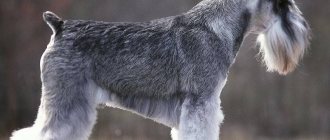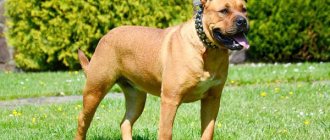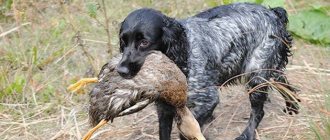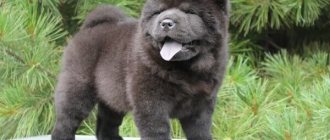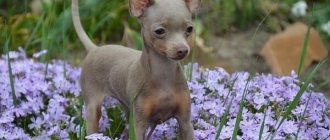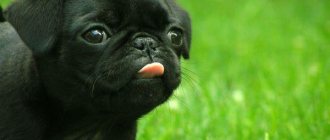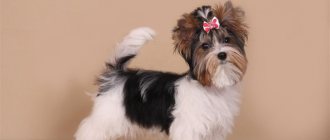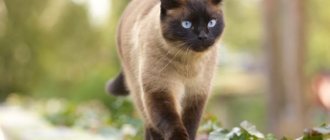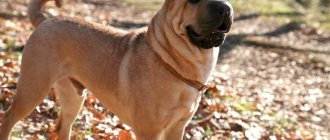History of the Bernese Mountain Dog breed
Bernese Mountain Dog
The distant ancestors of today's Mountain Dogs are considered to be Molossians, which were bred by the ancient Romans. Representatives of this breed were considered all-round dogs, since each individual combined fighting, herding and guard qualities. Molossians also accompanied the Romans on military campaigns, which helped the dogs reach the Alps and leave offspring in the territory of modern Switzerland, which gave rise to the family branch of the Sennenhunds.
Swiss peasants quickly appreciated the endurance and good-natured disposition of these large dogs, adapting them to work in cheese factories and transport milk along mountain trails. Until the middle of the 19th century, Mountain Dogs regularly grazed cows on alpine lawns, working part-time as dairy product distributors, but they were soon forced out of this niche by Saint Bernards. In some remote areas, the descendants of the Roman Molossians were still bred, but not so zealously, which is why the famous tricolor color was becoming less and less common among animals.
For a long period of time, Swiss Mountain Dogs were equated with mongrels and were not listed among breeders. Only at the end of the 19th century did these dogs begin to attract the interest of specialists, which became the main impetus for the emergence of the branch of Bernese Shepherd Dogs. The fundamental role in the formation of the breed was played by the Burdorf winemaker F. Schertenleib. The entrepreneur fell in love with Alpine dogs so much that he tirelessly traveled around the province of Dürbach in search of suitable “specimens” for his kennel.
The name “Bernese Mountain Dog” was given to this branch by Professor of the University of Zurich Albert Heim, who also formulated its main “identifying features”. Well, in 1907 the first breed standard was adopted, which, in fact, was a pure formality. As a result, Bernese Mountain Dogs were exhibited in European salons for quite a long time without pedigrees or registration numbers.
An interesting fact: in the 40s of the 20th century, as a result of an accidental mating of a Bernese Mountain Dog with a Newfoundland, Swiss Cattle Dogs were able to improve their natural performance. For example, Bernese Shepherds have acquired shinier and longer hair, and their temperament has become more phlegmatic.
The peak of Bern's popularity occurred in the 80s of the last century. Calm and friendly shepherd dogs enjoyed constant prestige among European and American breeders. Representatives of this breed were brought to Russia from Hungary, Poland, Czechoslovakia and Germany.
Is there a shorthaired and a dwarf mini?
The Bernese Mountain Dog is one of the representatives of the large Mountain Dog family. He is the only one in the whole family that has long, thick fur. But its closest relatives and species of this breed - the Greater Swiss Mountain Dog, the Entlebucher Mountain Dog, the Appenzeller Mountain Dog and the Greater Swiss Mountain Dog - are short-haired and smooth-haired: look at the photo comparison
Grosser / Bernese / Appelzellner / Entlebucher
There is also a mini Mountain Dog: the Entlebucher Mountain Dog. Its weight ranges from 22 to 30 kilos, its height is about 50 cm. It is an affectionate and friendly dog, perfect for keeping in an apartment.
Read more about this: Become a Breed Expert: All About Mountain Dogs
Appearance of Bernese Mountain Dogs
Bernese Mountain Dog puppy at 6 weeks
Bernese Shepherds are fairly large dogs with long black and fawn hair and white spots on the nose, neck and paws. The breed is considered to be the so-called “smile” Bernese. In a calm state, the muscles of the dog’s muzzle and head relax, opening its mouth slightly and creating the illusion of human facial expressions. The reference height at the withers for males is from 64 to 70 cm, for females - from 58 to 67 cm. The average weight of the Bernese Mountain Dog ranges from 39-50 kg for males, 38-48 kg for females.
Head
Proportional, large. The skull is massive, rounded, which is especially noticeable when looking at the animal in profile. The frontal groove is not clearly expressed. The transition from the frontal part to the muzzle is smooth, without sharp lines. The nose is large, black, with large nostrils.
Jaws and teeth
The standard bite is a scissor bite, but in some cases a pincer (straight) option is also acceptable. The teeth of the Bernese Mountain Dog are large, strong, and located in one line.
Eyes
The eyes are medium-sized, almond-shaped, set straight. The shade of the iris is dark brown, the whites of the eyes are not noticeable. The eyelids are dry and black (“damp” eyelids are considered defects).
Ears
Medium size, regular triangular shape, set high. At rest, pendulous, the tip of the ear is slightly rounded. When the Bernese Mountain Dog is alert, the front of the ear continues to remain flat against the skull, while the back of the ear is raised slightly.
Neck
Medium length, muscular, with a prominent scruff and well-developed withers.
Bernese Mountain Dog muzzle
Body
The body is compact, strong, with a wide, straight back and a deep, long chest. The ribs are convex. The loin is short, slightly narrower than the chest and croup.
Limbs
The Bernese Mountain Dog's forelimbs are straight, even, and set wide apart. The shoulder blades are elongated, tilted back. The humeroscapular angle is usually 100°. The hind legs are straight, strong, and muscular. The thighs are elongated, with developed muscles. The hock joints are strong, with a pronounced angle. Dewclaws (rudimentary finger-like processes located above the paws of the hind legs) in purebred individuals must be removed. The paws are directed forward, rounded, with elastic pads. The hind legs are collected into a less prominent “lump” than the front legs.
Tail
The tail of the Bernese Mountain Dog is massive, saber-shaped, tapering from the base towards the end. In a calm animal it is lowered, in an excited animal it rises to the level of the back and higher.
Wool
Long, straight, with a spectacular shine. May have slight “waves” in places.
Color
The predominant body color of the Mountain Dog is black. Areas of rich fawn coat are located on the chest, all four legs and above the eyes. White markings in Bernese Shepherds can be on the head in the form of a groove (should not reach the fawn areas of the coat), on the muzzle in the form of a spot (should not extend beyond the corners of the mouth) and chest. White “socks” on the paws and a white tip of the tail are also considered ideal parameters. The presence of small white “fragments” in the back of the head and anus is acceptable.
Major vices
Bernese Mountain Dog paw
Bernese Mountain Dogs may have deviations from the breed standard:
- too light frame;
- incorrect placement of incisors with correct bite;
- curly wool;
- the absence of white “flaps” on the head, as well as their excess quantity;
- black body color with a pronounced brown or red undertone;
- color asymmetry;
- the white areas of the coat have a grayish tint.
To disqualify a show class animal, the following defects are sufficient:
- progenia (overshot) or undershot;
- entropy (inversion of the eyelid);
- creases in the tail, or a tail curled into a donut;
- split nose;
- short coat, or the so-called “double coat” (when the undercoat “eclipses” the guard hair);
- aggression or cowardice of the animal;
- cryptorchidism;
- insufficient growth.
Disqualifying faults
- Cowardice, aggressive and nervous behavior
- Obvious physical or behavioral abnormalities
- Blue eyes (one or both) – more common in dogs with a large area of white on the head.
- Entropy (eyelids turned inward), ectropia (eyelids turned outward)
- Kink in the tail, tail in a ring
- Split nose
- Underbite, overbite or misalignment
- Double-layered, short coat. A coat color other than tricolor. The main coat color is not black.
Similar articles:
- Mating of the Bernese Mountain Dog
- Coat type and color of the Bernese Mountain Dog
- Personality of the Bernese Mountain Dog
- History of the origin of the Bernese Mountain Dog
Photo of an adult Bernese Mountain Dog
Personality of Bernese Mountain Dogs
Bernese Shepherds are extremely kind, obedient and devoted friends who will not harass their owner with demands for increased attention and a violent temperament. Berns are calm and infinitely wise, but at the same time they are not “crackers” and are quite capable of expressing feelings. Representatives of this breed are typical family dogs. By the way, despite the fact that Mountain Dogs are not considered ideal nannies, they treat children patronizingly, with a sense of slight superiority, and do not respond to annoying pranks with aggression.
Bernese Mountain Dog with a child
Young individuals are usually very inquisitive and a little careless, they allow themselves to fool around in moderation, but do not go too far. Adult and experienced dogs are calmer and more phlegmatic. These imperturbable giants will no longer be fooled by a cat running across the road or other simple provocations. Bernese Mountain Dogs love to play as helpers, guides and guards. They are happy to carry their owner's small purchases or protect him from other dogs. Burns also make excellent animators: teach your pet to walk in a sled, and he will be happy to push your children in a cart. The legendary fearlessness of the Berns brings them more trouble than good. Representatives of this breed often perform unnecessary feats, such as jumping from a balcony, which end in failure for the dog itself.
In general, Mountain Dogs are patient and affectionate, respectful of people. Speaking of respect: Bernese Shepherds treat strangers calmly, without showing aggression, but also without much sympathy. Usually only one family member becomes the most respected in the eyes of the animal. This, of course, does not mean that the dog does not obey other people. It’s just that the pet will not carry out the commands of the “secondary” owners as actively. Despite the slight laziness and love of sleep that periodically descend on representatives of this breed, Bernese gladly take part in outdoor games. True, due to their nature, they don’t like to have fun for too long.
Interesting Facts
- In the Middle Ages, Sennenhunds were used to transport heavy objects. In those days, it was often possible to see these beautiful, powerful animals harnessed to a cart carrying milk or vegetables to the market in the nearest city. By the way, in small towns and villages of modern Swiss cantons and still large Sennenhunds are used in this capacity.
- During World War II, Mountain Dogs, along with German Shepherds, Doberman Pinschers, Boxers, Great Danes, Collies and other working dogs, fought on the Western Front as signal dogs, orderlies, miners, and also helped transport cargo.
- Sennenhunds are essentially Saint Bernards; they differ from the latter only in color and some features in the structure of the skeleton.
- According to the International Canine Poll, Mountain Dogs are among the three most beautiful dog breeds in the world.
- Bernese Mountain Dogs simply love to give children rides if they are harnessed in a small cart.
- There is a beautiful legend about how the Pyrenean Mountain Dogs came to be. One winter, a little girl got lost in the mountains, she got scared and froze. But the gods, responding to her prayers, turned the snowdrifts surrounding the child into large and fluffy white dogs. They warmed her with their warmth and helped her get home. Local residents, in gratitude, kept these dogs with them, and they began to graze their flocks and protect their houses from thieves and wild animals.
- All Mountain Dogs belong to the Molosser group, which are considered universal dogs suitable for a wide variety of work. They can equally well be guards, fighters, bodyguards, shepherds, rescuers and just companions.
- Mountain Dogs love water and are very good swimmers, which makes them similar to Newfoundlands.
- Large Mountain Dogs are healthier than other giant breeds and live longer.
- If a mountain dog living in a village is left unattended on the street, then there is a high probability that the dog, following its herding instincts, can drive a whole litter of different animals into the owner’s yard.
Swiss and Pyrenean Mountain Dogs are breeds bred for work, which nowadays, having almost lost their original purpose, have become simply good guards, rescuers, as well as companions and guides. These friendly, affectionate animals will fit well into a large family, becoming loyal and devoted friends for adults and attentive and gentle nannies for children. And, although most Sennenhunds are not intended for urban keeping, the Appenzeller or Entlebucher, if given the necessary physical activity, will get along well in an apartment.
If you are a happy owner of a mountain dog, share a story about your pet, your experience in choosing, maintaining or raising these dogs, and, of course, do not forget to post photos of your pet in the comments.
Education and training
Bernese Mountain Dogs require mandatory socialization, and the sooner you start teaching your puppy commands, the better for both of you. Despite their calm appearance, Bernese Shepherds are very sensitive dogs, so you should not shout at your pet, or use physical violence towards him. In education, it is recommended to show a certain firmness and perseverance: for mistakes, the puppy should be given suggestions in a strict tone (the punishment system for small puppies, as a rule, is not applied).
Mountain dog training
The age from 4 to 8 months is the period of maximum disobedience and pranks. At this time, the dog is teething, so Bernese Mountain Dogs actively taste the surrounding reality. Sometimes the object of attention becomes not only slippers and shoes, but also the fingers of family members. In order not to stock up on iodine and bandages later, teach the dog not to consider the owner’s hands as an object for play. If the puppy does start biting your fingers, lightly pinch his nose. The pain will sober up the animal and will not cause any significant harm to it.
From the first months of life, begin to gradually wean your dog from spontaneous jumping. While the animal is small, such an expression of tender feelings causes sincere affection, but when, after a couple of years, a shaggy 50-kilogram carcass jumps into your arms, it will cease to be a pleasure.
Important: Bernese Mountain Dogs mature later than other breeds, so complex training should only be practiced with individuals who have reached the age of two.
You should start training your pet by wearing a collar and the simplest commands “Come to me!”, “Ugh!” and others. Even an animal one and a half months old can learn these simple lessons. Spend 10 to 15 minutes on training. per day to avoid overtiring your puppy, and be sure to use tasty rewards, either purchased from a pet store or homemade. And under no circumstances overdo it. Discipline should not turn into a set of prohibitions that restricts the pet’s freedom: after all, for normal development, the puppy needs to come into contact with things and other animals as often as possible. Those who see their Bernie as a future watchman should develop the dog’s ability to divide people into friends and foes. This also includes such a skill as refusing to accept treats from the hands of a stranger. Exceptions are unacceptable even for “good friends”.
Shepherds with the soul of aristocrats
There are no more loyal partners than Bernese Mountain Dogs. The owner is their god and the meaning of life. Therein lies the problem - dogs have a hard time being separated even for a couple of days and rarely become attached to the new owner.
Otherwise, the character of the pets is golden. They are loving, but not intrusive. They subtly sense people's moods: they know when to fool around and when to console. Puppies are playful, but they play pranks with an eye to the consequences.
Animals are good-natured towards household members, guests and passers-by. Because of this, dogs are not suitable for protection. Of course, they have a guard instinct and will defend their owner in case of danger. In addition, one formidable appearance will scare off ill-wishers. But aggression is not in the nature of the Berns.
The Swiss Cattle Dog has a clear, loud voice. But he rarely serves it. So you don’t have to worry about your neighbors’ sleep and peace of mind.
Care and maintenance
I am a pirate!
A home for a Bernese Mountain Dog can be either a village cottage or a city apartment. For individuals guarding a private home, it is more advisable to build housing in the courtyard. Usually, the shepherd dogs are fenced off with an enclosure in which a booth is installed. If your pet will live in an apartment, it is best to give him a corner on the balcony (provided that it is glazed). To prevent the animal from freezing in the off-season, you can set up a small kennel on the balcony.
In the summer, it is also necessary to monitor the temperature on the balcony: the sun strongly warms up the walls of the house, which does not have the best effect on the dog’s health. For those who plan to keep a Bernese in an apartment, it makes sense to take care of purchasing a playpen in which to place the dog in case of your own absence. It is better to place it away from radiators and heating devices.
Bernese Shepherds are supposed to be walked twice a day, and it is advisable to combine walking with active physical activity. You can get your dog to run or take part in some simple play to burn extra calories and improve muscle tone.
Hygiene
Since Bernese Mountain Dogs shed heavily, they need to be brushed every day. But you shouldn’t bathe your dog too often. A bath day for representatives of this breed is held no more than once a month, except in cases where your pet managed to get thoroughly dirty during a walk. It is advisable not to wet the animal’s head at all while washing it to avoid water getting into the ears. Shampoo is used as needed and in very limited quantities; a hair dryer is used only for drying adults. After bathing, remove excess moisture from the coat with a towel and make sure that the animal does not sit in a draft until it dries. After drying, the wool is combed.
The Bernese Mountain Dog's ears should be examined once a week. If you are walking an animal in a forest belt, it is better to check it after each walk. Contaminants from the ear funnel are removed using a cotton pad moistened with boiled water. It is not recommended to use cotton swabs to avoid damage to your hearing. Bernese Mountain Dogs should have their nails trimmed once every two weeks. Removing yellow plaque from the surface of the teeth is done with a special paste applied to a cotton swab 1-2 times a week.
Feeding
Two-month-old puppies are fed up to 5 times a day, three-month-old puppies - 4 times, seven-month-old adolescents are transferred to three meals a day, and by the age of one year the dog should eat twice a day. An animal under two months of age should receive fermented milk products such as cottage cheese, curdled milk or kefir every day. Pure milk is not allowed. Meat is introduced into the Sennenhunds’ diet gradually, in combination with boiled cereals and vegetables.
Omnomnom
The “menu” of a natural-fed adult must include lean meat or offal, sea fish fillets (frozen), and fermented milk products. It is recommended to give vegetables (carrots, pumpkin, broccoli) along with meat, and for “dessert” you can pamper your pet with a piece of banana, apple or pear. The amount of cereal products consumed by the animal should be at least 10% of the total diet. A couple of times a week, you can treat your Bernese Mountain Dog to a raw yolk or hard-boiled egg.
Owners who prefer to feed their pet “dry food” should take care of looking for food with low fat content (no more than 16%) and with a protein content of 18 to 26%. Try to choose varieties that do not contain soy, corn or wheat. A healthy adult animal should consume from 1800 to 3000 kcal per day, a two-month-old puppy should consume about 600 kcal, while an older, inactive dog will need 1500 kcal.
Toilet
To toilet train the Bernese Mountain Dog, it is usually walked after meals. If the puppy did not wait for a walk and made a puddle in the apartment, it is useless to scold him. But patience and the fulfillment of natural needs in the right place are worth rewarding. In the first months of life, the puppy needs to be taken outside more often in order to catch the moment when he wants to relieve himself. An adult animal, whose skill has already been formed, is able to endure. As for the indoor toilet, rubber mats, newspapers or diapers are usually used for such cases to help keep the floor clean.
Socialization
The Bernese Mountain Dog or Bernese Shepherd will make friends with anyone whom the owner brings into the house: a significant other, a child, a kitten, a hamster or a parrot. The dog perceives everyone as friends.
Bern gets along well with other pets. Friendship with cats is possible if a Bernese Mountain Dog puppy grows up and lives with kittens from the first months.
Bernese Mountain Dogs love children. They will never offend them, unless they accidentally push them or crush them with their fifty kilograms. But they won’t become nannies. The pets will play with the kids, but they will quickly get tired and leave the kids to another place.
At the same time, the Bernese Cattle Dog fiercely protects the child. His safety is the most important thing. More important than the master's orders. If the pet thinks that following a command will harm the baby, it will refuse to obey.
Bernese Mountain Dog Health and Diseases
Bernese Mountain Dog with cat
Bernese Mountain Dogs are dogs with good heredity, but a constant companion of “apartment” dogs – physical inactivity and constant stress can seriously undermine the pet’s health. The average lifespan of a Bernese Shepherd is 8-10 years. In the absence of serious diseases and quality care, some representatives of this breed “hold out” to their 13th birthday, which is considered a kind of record.
Typical diseases of Bernese Mountain Dogs:
- dysplasia of the elbow and hip joints (not a death sentence and, with well-chosen treatment, may not cause discomfort to the pet);
- osteochondrosis of the shoulder;
- problems with the visual organs (cataracts, entropion, retinal atrophy);
- alopecia (hair loss, baldness of the animal);
- weeping eczema;
- umbilical hernia;
- overheating (heat stroke).
Like representatives of many other breeds, Bernese are susceptible to cancer. In addition, some individuals may exhibit hereditary kidney pathologies.
Breed characteristics
The Bernese Shepherd (photo shown in the article) is a tri-colored animal with long and thick hair. They have a strong build, and at the same time, the dogs are incredibly mobile. The dogs are well built. They are very affectionate and kind with close people, but with strangers they are quiet and calm. Animals are very trainable. The Swiss even joke that the Bernese Shepherd is born already trained; you just need to remind it of commands.
Males reach 70 centimeters at the withers, and females reach 58-66 centimeters. Animals weigh 45-47 kilograms.
How to choose a puppy
Bernese Mountain Dog puppies should be adopted between the ages of 2 and 6 months.
Males of this breed look more impressive due to their impressive size, but are more difficult to train. Females are more flexible and intelligent, but during the period of heat, an irresistible “craving for travel” awakens in them, which can become a serious problem for the owner. Be sure to evaluate the situation in the nursery by looking into the enclosures where the animals live and carefully studying their standard menu. Getting to know the puppy’s parent, as well as his veterinary record, will also not be superfluous. The greatest demand is for frisky, playful and inquisitive puppies: this behavior signals that the animal is healthy and kept in acceptable conditions. At a young age, Bernese dogs may have a modified coat structure: it may be too straight or, conversely, curly, and also have a grayish undertone. All these features are not considered defects and disappear with age.
Peculiarities
- If you try to describe the Bernese Mountain Dog in two words, then these words would be good nature and loyalty . The breed is aimed at serving people, and this is manifested in all the actions of the Bernese: he will play with all family members, take care of babies, and be calm with cats and small pets. And when the whole family gathers in one room, they won’t refuse to take a nap next to each other!
- When walking, these dogs are quite phlegmatic . At the same time, sometimes the genes of herding dogs awaken in them. Then the Bernese can begin to “shepherd his flock”: take care of his household and especially his children, trying to gather them in one place that, in his opinion, is safe.
- Bernese love to swim and play in the snow, but in the summer their activity decreases because the dog with its thick coat is hot.
- Unfortunately, extraordinary attachment to the owner can play a cruel joke on the Bernese Mountain Dog: the dog very quickly begins to feel sad when separated from its family . The chances that an adult Bernese will adapt to new owners are very low. But being surrounded by love, this dog will repay you what you deserve with devotion and obedience!

